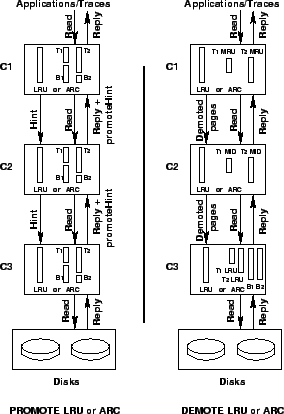
To facilitate the adaptation, PROMOTE requires a very simple interface to periodically receive adaptation information like the
cache life (the timestamp difference between the MRU and LRU pages in the cache) of the next higher cache(s).
At regular intervals, each cache, other than the lowest, sends the hint to the next lower cache
(Lines 1-3), using which, the
![]() is computed (Lines 23, 41-43). The goal is to adapt
is computed (Lines 23, 41-43). The goal is to adapt
![]() in such a way that the
in such a way that the
![]() approaches
approaches ![]() (a value that implies that the usefulness of pages evicted from the higher cache is the same as of those from the lower cache).
If the higher cache has a larger life (
(a value that implies that the usefulness of pages evicted from the higher cache is the same as of those from the lower cache).
If the higher cache has a larger life (
![]() ),
),
![]() is increased, else it is decreased.
Since there is a lag between the adaptation in
is increased, else it is decreased.
Since there is a lag between the adaptation in
![]() and its impact on the
and its impact on the
![]() , the recomputation of
, the recomputation of
![]() (Lines 4-17) is done only on alternate times the hint is received (Line 3). Further, if the previous adaptation of
(Lines 4-17) is done only on alternate times the hint is received (Line 3). Further, if the previous adaptation of
![]() is found to have reduced the separation of
is found to have reduced the separation of
![]() and
and ![]() by a reasonable fraction (Lines 7-10), then no further adaptation is done.
To avoid any runaway adaptation,
by a reasonable fraction (Lines 7-10), then no further adaptation is done.
To avoid any runaway adaptation,
![]() needs to be carefully adapted so that the adaptation is proportional to the difference between
needs to be carefully adapted so that the adaptation is proportional to the difference between
![]() and
and ![]() and also is slower when close to extreme values of 0 and
and also is slower when close to extreme values of 0 and ![]() (Lines 11-12).
To start off in a fair fashion,
(Lines 11-12).
To start off in a fair fashion,
![]() is initialized according to the sizes of the caches. Since the higher caches usually demonstrate higher hit rates than the lower caches, we forbid
is initialized according to the sizes of the caches. Since the higher caches usually demonstrate higher hit rates than the lower caches, we forbid
![]() to go beyond the ratio thus determined (Lines 13-14).
to go beyond the ratio thus determined (Lines 13-14).
 |
Let us examine some examples of PROMOTE in existing cache management policies: